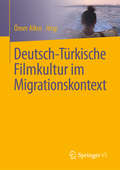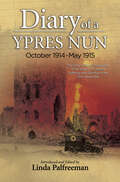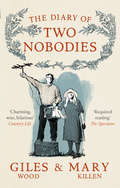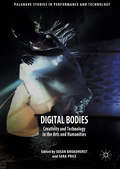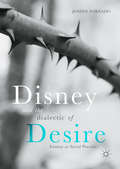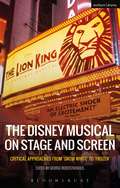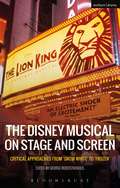- Table View
- List View
Deep Drama: Exploring Life as Theater
by Karl E. ScheibeThis book applies a dramaturgical perspective to familiar psychological topics including fear, greed, shame, guilt, rejection, well-being and terrorism. In presenting vivid illustrations of how our understanding of psychological problems can be enriched and enlivened by employing dramatic language and concepts, it brings the well-established field of narrative psychology to life. Providing an accessible and fresh understanding of psychological problems through the language and concepts of theatre, Karl Scheibe builds on the work of leading scholars in the field including Sarbin, Gergen, Bruner and Goffman. This exciting and accessible book acts as a sequel to Scheibe's, The Drama of Everyday Life, and will appeal to students and scholars of narrative and social psychology, theatre studies and the studies of self and identity.
Der Wuxia-Film und die aktuelle Gesellschaft Chinas: Eine strukturelle Analyse des Wuxia-Genres
by Gongpu SongGongpu Song ergänzt in seinem Buch den aktuellen Forschungsstand zum Wuxia-Film und bietet eine Perspektive für Untersuchungen der gesellschaftlichen Transformation Chinas. Der Autor zeigt, dass es zwischen dem politischen und gesellschaftlichen Wandel Chinas und der Beliebtheit des Wuxia-Films einen Zusammenhang gibt und macht deutlich wie sich die aktuellen Wandlungen Chinas in diesem Genre wiederspiegeln. Seit 1978 hat China einen großen sozialen Wandel erfahren, die ehemaligen sozialistischen Ordnungen wurden zerstört und die Gesellschaft wird durch marktwirtschaftliche Strukturen geprägt. Auch die Bevölkerungswanderung wird zu einem bemerkenswerten sozialen Phänomen Chinas. In dieser Zeit gewinnt der Wuxia-Film immer mehr an Popularität.
Deutsch-Türkische Filmkultur im Migrationskontext
by Ömer AlkınDas Buch bietet mit einer mehr als 40 Jahre Migrationskino thematisierenden Bandbreite an Aufsätzen, Interviews und Filmographien ein umfassendes Nachschlagewerk zum deutsch-türkischen Kino an. Mit diesem erhalten Lehrende, Forschende und Studierende der Film-, Medien- und Kulturwissenschaften erstmalig einen Überblick über die Diversität des deutsch-türkischen Kinos, die von der Repräsentation der Emigration im türkischen „Yeşilçam“-Kino der 1960er bis zu den kulturell hybriden Identitätsangeboten des neuen deutsch-türkischen Migrationskinos reicht.
Developing Story Ideas: The Power and Purpose of Storytelling
by Michael RabigerThe vast majority of screenplay and writing books that focus on story development have little to say about the initial concept that inspired the piece. Developing Story Ideas: The Power and Purpose of Storytelling, Third Edition provides writers with ideational tools and resources to generate a wide variety of stories in a broad range of forms. Celebrated filmmaker and author Michael Rabiger demonstrates how to observe situations and themes in the writer’s own life experience, and use these as the basis for original storytelling. This new edition has been updated with chapters on adaptation, improvisation, and cast collaboration’s roles in story construction, as well as a companion website featuring further projects, class assignments, instructor resources, and more. Gain the practical tools and resources you need to spark your creativity and generate a wide variety of stories in a broad range of forms, including screenplays, documentaries, novels, short stories, and plays Through hands-on, step-by-step exercises and group and individual assignments, learn to use situations and themes from your own life experience, dreams, myth, and the news as the basis for character-driven storytelling; harness methods of screenplay format, dialogue, plot structure, and character development that will allow your stories to reach their fullest potential
Developing Story Ideas: The Power and Purpose of Storytelling
by Michael RabigerThe vast majority of screenplay and writing books that focus on story development have little to say about the initial concept that inspired the piece. Developing Story Ideas: The Power and Purpose of Storytelling, Third Edition provides writers with ideational tools and resources to generate a wide variety of stories in a broad range of forms. Celebrated filmmaker and author Michael Rabiger demonstrates how to observe situations and themes in the writer’s own life experience, and use these as the basis for original storytelling. This new edition has been updated with chapters on adaptation, improvisation, and cast collaboration’s roles in story construction, as well as a companion website featuring further projects, class assignments, instructor resources, and more. Gain the practical tools and resources you need to spark your creativity and generate a wide variety of stories in a broad range of forms, including screenplays, documentaries, novels, short stories, and plays Through hands-on, step-by-step exercises and group and individual assignments, learn to use situations and themes from your own life experience, dreams, myth, and the news as the basis for character-driven storytelling; harness methods of screenplay format, dialogue, plot structure, and character development that will allow your stories to reach their fullest potential
Diagnosing Contemporary Philosophy with the Matrix Movies
by O. Bradley BasslerThis book charts the shape of future philosophical investigation by posing the question: “What is the Matrix?” Guided by the example of the Matrix film trilogy, the author examines issues ranging from simulation, proof and action to value, culture and mythology, offering a progressively deeper diagnosis of modern philosophical conditions. In contrast to the contemporary focus upon cognitive science and a commitment to the distinction between appearance and reality, this book helps readers to explore the argument that such abstractions are inevitably displaced by a more concrete distinction between dreaming and waking, with the Matrix as the real and only world we inhabit. Researchers and scholars will find this work an engaging and enlightening examination of reality, via the medium of popular culture and film.
Diary of a Ypres Nun: October 1914-May 1915
by Linda PalfreemanThe Diary of Soeur Marguerite of the Sisters of Lamotte Suffering and Sacrifice in the First World War. The campaign in Flanders, with its successive battles, would be the longest of the Great War and the costliest in terms of human life. At the centre of the fearful and prolonged barrages of shelling by the military of both sides lay the town of Ypres, known for its Cloth Hall and cathedral, its butter and its lace -- now to be blasted to infamy as an indelible symbol of suffering and sacrifice and wanton destruction. The underground passageways of the towns ancient fortifications provided shelter for the trapped townspeople. In desperate circumstances courageous and selfless individuals administered medical attention, distributed food and clothing, provided milk for babies and set up orphanages and schools for children. Some of these volunteers, such as the Friends' Ambulance Unit (FAU), came from afar, whilst others already formed an essential part of the moral and social fibre of the beleaguered town: these included the local priest, Camille Delaere, and the nuns who lent him their support. The cures indefatigable assistant was the young nun Soeur Marguerite of the Sisters of Lamotte, and it is her daily journal that became The Diary of an Ypres Nun. Originally published in French in 1917, this harrowing yet sometimes surprisingly humorous account of events in the besieged and battered town of Ypres was written between October 1914 and May 1915, as she worked alongside the FAU and Father Delaere, to bring comfort and succour to the suffering civilian population.
The Diary of Two Nobodies
by Mary Killen Giles WoodWelcome to Giles and Mary reality.Giles is a countryman who relishes solitude. His wife Mary thrives in company and enjoys frequent escapes to London.After thirty years in a marriage of opposites, Giles and Mary have adapted to a life of domestic misunderstandings within comical misadventures.In The Diary of Two Nobodies, you will have the unique opportunity to discover, first hand, what occurs when a man who sees himself as a cross between Mr Bean and Basil Fawlty shares his life with a woman who identifies closely with the Queen.Featuring original illustrations by the artist Giles, himself.
Digital Bodies: Creativity and Technology in the Arts and Humanities (Palgrave Studies in Performance and Technology)
by Sara Price Susan BroadhurstThis book explores technologies related to bodily interaction and creativity from a multi-disciplinary perspective. By taking such an approach, the collection offers a comprehensive view of digital technology research that both extends our notions of the body and creativity through a digital lens, and informs of the role of technology in practices central to the arts and humanities. Crucially, Digital Bodies foregrounds creativity, the interrogation of technologies and the notion of embodiment within the various disciplines of art, design, performance and social science. In doing so, it explores a potential or virtual new sense of the embodied self. This book will appeal to academics, practitioners and those with an interest in not only how digital technologies affect the body, but also how they can enhance human creativity.
Digital Compositing with Blackmagic Fusion: Essential Techniques
by Lee LanierCreate complex composites with Blackmagic Fusion. Learn the basics of node-based compositing and get up to speed quickly so you can undertake your own compositing projects. In Digital Compositing with Blackmagic Fusion: Essential Techniques, industry veteran Lee Lanier covers the most important components, tools, and workflows any serious compositor needs to know. Practice your knowledge and skill as you read the book with the included mini-tutorials and longer chapter tutorials. An accompanying eResource features video image sequences, 3D renders, and other tutorial materials, allowing you to immediately practice the discussed techniques. Critical topics in this book include: Tool / Node networks Color space and color channels Transformations Masking and rotoscoping Keyframing and animation splines Green screen keying The Fusion 3D environment Color grading and color manipulation Filter tools Motion tracking Particle simulation Stereoscopic workflow
Digital Compositing with Blackmagic Fusion: Essential Techniques
by Lee LanierCreate complex composites with Blackmagic Fusion. Learn the basics of node-based compositing and get up to speed quickly so you can undertake your own compositing projects. In Digital Compositing with Blackmagic Fusion: Essential Techniques, industry veteran Lee Lanier covers the most important components, tools, and workflows any serious compositor needs to know. Practice your knowledge and skill as you read the book with the included mini-tutorials and longer chapter tutorials. An accompanying eResource features video image sequences, 3D renders, and other tutorial materials, allowing you to immediately practice the discussed techniques. Critical topics in this book include: Tool / Node networks Color space and color channels Transformations Masking and rotoscoping Keyframing and animation splines Green screen keying The Fusion 3D environment Color grading and color manipulation Filter tools Motion tracking Particle simulation Stereoscopic workflow
Digital Resistance in the Middle East: New Media Activism in Everyday Life
by Deborah WheelerCombines development theory with practice through a case study of the West African community of Tostan
Digital Resistance in the Middle East: New Media Activism in Everyday Life (Edinburgh University Press)
by Deborah WheelerExamines the phenomenon of extreme cinema through an in-depth application of paratextual theory
Digital Storytelling: Form and Content
by Tricia Jenkins Mark DunfordThis edited collection brings together academics and practitioners to explore the uses of Digital Storytelling, which places the greatest possible emphasis on the voice of the storyteller. Case studies are used as a platform to investigate questions of concept, theory and practice, and to shine an interrogative light on this emergent form of participatory media. The collection examines the creative and academic roots of Digital Storytelling before drawing on a range of international examples to consider the way in which the practice has established itself and evolved in different settings across the world.
Directing: Behind the Silver Screen: A Modern History of Filmmaking
by Virginia Wright WexmanOf all the artisans who work in the American film industry, directors have been given the lion's share of attention. Yet few books in this literature address the ways directors have worked with others and have negotiated the constraints and opportunities posed by a complex production process and a sprawling commercial industry. Directing fills this gap. It provides the historical context necessary to understand the key role of directors in the Hollywood system. It covers iconic directors like Cecil B. DeMille, Francis Ford Coppola and Terrence Malik. It also shows how a selection of remarkable filmmakers confronted issues encountered during a given period; for example, how Ida Lupino negotiated 1950s ingrained sexism and how black directors like Charles Burnett operated in the system. It follows the working strategies of independents like Steven Soderbergh or Tim Burton and of directors dealing in twenty-first century digital cinema. Both readable and detailed, the book has appeal across the study of film and film production to the broader interest in the director's art.
Directing and Producing for Television: A Format Approach
by Ivan CuryDirecting and Producing for Television provides essential tools required to direct and produce effectively in a variety of settings. Ideal for students in television production courses, Directing and Producing for Television addresses critical production techniques for various formats, including multiple-camera panel productions, news and demonstration programs, as well as scripted and musical productions, documentaries, sports, commercials, and PSAs. In full color for the first time, this new edition has been updated to include information about online distribution platforms like YouTube and Vimeo, and new production tools such as action cameras, smart phones, DSLRs, and drones. New, full-colour images throughout give this classic text a fresh look featuring today’s latest technology Written by an expert with years of experience in both the industry and in teaching television directing and producing An approachable writing style brings a real world perspective to the procedures and protocols of a demanding industry Visuals showing camera setups and accompanying shots illustrate the best approach to a variety of formats and the related challenges for each
Directing and Producing for Television: A Format Approach
by Ivan CuryDirecting and Producing for Television provides essential tools required to direct and produce effectively in a variety of settings. Ideal for students in television production courses, Directing and Producing for Television addresses critical production techniques for various formats, including multiple-camera panel productions, news and demonstration programs, as well as scripted and musical productions, documentaries, sports, commercials, and PSAs. In full color for the first time, this new edition has been updated to include information about online distribution platforms like YouTube and Vimeo, and new production tools such as action cameras, smart phones, DSLRs, and drones. New, full-colour images throughout give this classic text a fresh look featuring today’s latest technology Written by an expert with years of experience in both the industry and in teaching television directing and producing An approachable writing style brings a real world perspective to the procedures and protocols of a demanding industry Visuals showing camera setups and accompanying shots illustrate the best approach to a variety of formats and the related challenges for each
Directing for the Screen (PERFORM)
by Anna WeinsteinDirecting for the Screen is a collection of essays and interviews exploring the business of directing. This highly accessible guide to working in film and television includes perspectives from industry insiders on topics such as breaking in; developing and nurturing business relationships; the director’s responsibilities on set and in the field; and more. Directing for the Screen is an ideal companion to filmmaking classes, demystifying the industry and the role of the director with real-world narratives and little-known truths about the business. With insight from working professionals, you’ll be armed with the information you need to pursue your career as a director. Contains essays by and interviews with television directors, feature directors, documentary filmmakers, commercial directors, producers, and professors. Offers expert opinions on how to get started, including landing and succeeding in an internship and getting your first gig. Reveals details about working with actors, overseeing the work of often hundreds of crewmembers, writing last-minute on set, and developing a working relationship with producers and screenwriters. Explores strategies for doing creative work under pressure, finding your directorial voice, financing shorts and independent films, breaking down barriers and overcoming discrimination, shooting in less-than-ideal situations, and recovering from bad reviews or box office results. Illuminates the business of directing in the United States (New York and Los Angeles) as compared to other countries around the globe, including England, Ireland, Spain, Australia, Denmark, Pakistan, Belgium, and Canada.
Directing for the Screen (PERFORM)
by Anna WeinsteinDirecting for the Screen is a collection of essays and interviews exploring the business of directing. This highly accessible guide to working in film and television includes perspectives from industry insiders on topics such as breaking in; developing and nurturing business relationships; the director’s responsibilities on set and in the field; and more. Directing for the Screen is an ideal companion to filmmaking classes, demystifying the industry and the role of the director with real-world narratives and little-known truths about the business. With insight from working professionals, you’ll be armed with the information you need to pursue your career as a director. Contains essays by and interviews with television directors, feature directors, documentary filmmakers, commercial directors, producers, and professors. Offers expert opinions on how to get started, including landing and succeeding in an internship and getting your first gig. Reveals details about working with actors, overseeing the work of often hundreds of crewmembers, writing last-minute on set, and developing a working relationship with producers and screenwriters. Explores strategies for doing creative work under pressure, finding your directorial voice, financing shorts and independent films, breaking down barriers and overcoming discrimination, shooting in less-than-ideal situations, and recovering from bad reviews or box office results. Illuminates the business of directing in the United States (New York and Los Angeles) as compared to other countries around the globe, including England, Ireland, Spain, Australia, Denmark, Pakistan, Belgium, and Canada.
Disney and the Dialectic of Desire
by Joseph ZornadoThis book analyzes Walt Disney's impact on entertainment, new media, and consumer culture in terms of a materialist, psychoanalytic approach to fantasy. The study opens with a taxonomy of narrative fantasy along with a discussion of fantasy as a key concept within psychoanalytic discourse. Zornado reads Disney's full-length animated features of the "golden era" as symbolic responses to cultural and personal catastrophe, and presents Disneyland as a monument to Disney fantasy and one man's singular, perverse desire. What follows after is a discussion of the "second golden age" of Disney and the rise of Pixar Animation as neoliberal nostalgia in crisis. The study ends with a reading of George Lucas as latter-day Disney and Star Wars as Disney fantasy. This study should appeal to film and media studies college undergraduates, graduates students and scholars interested in Disney.
Disney and the Dialectic of Desire: Fantasy as Social Practice (PDF)
by Joseph ZornadoThis book analyzes Walt Disney’s impact on entertainment, new media, and consumer culture in terms of a materialist, psychoanalytic approach to fantasy. The study opens with a taxonomy of narrative fantasy along with a discussion of fantasy as a key concept within psychoanalytic discourse. Zornado reads Disney’s full-length animated features of the “golden era” as symbolic responses to cultural and personal catastrophe, and presents Disneyland as a monument to Disney fantasy and one man’s singular, perverse desire. What follows after is a discussion of the “second golden age” of Disney and the rise of Pixar Animation as neoliberal nostalgia in crisis. The study ends with a reading of George Lucas as latter-day Disney and Star Wars as Disney fantasy. This study should appeal to film and media studies college undergraduates, graduates students and scholars interested in Disney.
The Disney Musical on Stage and Screen: Critical Approaches from 'Snow White' to 'Frozen'
by George RodosthenousThe Disney Musical: Critical Approaches on Stage and Screen is the first critical treatment of the corporation's hugely successful musicals both on screen and on the stage. Its 13 articles open up a new territory in the critical discussion of the Disney mega-musical, its gender, sexual and racial politics, outreach work and impact of stage, film and television adaptations. Covering early 20th century works such as the first full-length feature film Snow White and the Seven Dwarfs (1937), to The Lion King - Broadway's highest grossing production in history, and Frozen (2013), this edited collection offers a diverse range of theoretical engagements that will appeal to readers of film and media studies, musical theatre, cultural studies, and theatre and performance. The volume is divided into three sections to provide a contextual analysis of Disney's most famous musicals: · DISNEY MUSICALS: ON FILM· DISNEY ADAPTATIONS: ON STAGE AND BEYOND· DISNEY MUSICALS: GENDER AND RACE The first section employs film theory, semiotics and film music analysis to explore the animated works and their links to the musical theatre genre. The second section addresses various stage versions and considers Disney's outreach activities, cultural value and productions outside the Broadway theatrical arena. The final section focuses on issues of gender and race portraying representations of race, hetero-normativity, masculinity and femininity in Newsies, Frozen, High School Musical, Aladdin and The Jungle Book. The various chapters address these three aspects of the Disney Musical and offer new critical readings of a vast range of important works from the Disney musical cannon including Enchanted, Mary Poppins, Hunchback of Notre Dame, The Lion King and versions of musicals for television in the early 1990s and 2000s. The critical readings are detailed, open-minded and come to surprising conclusions about the nature of the Disney Musical and its impact.
The Disney Musical on Stage and Screen: Critical Approaches from 'Snow White' to 'Frozen'
by George RodosthenousThe Disney Musical: Critical Approaches on Stage and Screen is the first critical treatment of the corporation's hugely successful musicals both on screen and on the stage. Its 13 articles open up a new territory in the critical discussion of the Disney mega-musical, its gender, sexual and racial politics, outreach work and impact of stage, film and television adaptations. Covering early 20th century works such as the first full-length feature film Snow White and the Seven Dwarfs (1937), to The Lion King - Broadway's highest grossing production in history, and Frozen (2013), this edited collection offers a diverse range of theoretical engagements that will appeal to readers of film and media studies, musical theatre, cultural studies, and theatre and performance. The volume is divided into three sections to provide a contextual analysis of Disney's most famous musicals: · DISNEY MUSICALS: ON FILM· DISNEY ADAPTATIONS: ON STAGE AND BEYOND· DISNEY MUSICALS: GENDER AND RACE The first section employs film theory, semiotics and film music analysis to explore the animated works and their links to the musical theatre genre. The second section addresses various stage versions and considers Disney's outreach activities, cultural value and productions outside the Broadway theatrical arena. The final section focuses on issues of gender and race portraying representations of race, hetero-normativity, masculinity and femininity in Newsies, Frozen, High School Musical, Aladdin and The Jungle Book. The various chapters address these three aspects of the Disney Musical and offer new critical readings of a vast range of important works from the Disney musical cannon including Enchanted, Mary Poppins, Hunchback of Notre Dame, The Lion King and versions of musicals for television in the early 1990s and 2000s. The critical readings are detailed, open-minded and come to surprising conclusions about the nature of the Disney Musical and its impact.
Divine Work, Japanese Colonial Cinema and its Legacy (Topics and Issues in National Cinema)
by Kate Taylor-JonesFor many East Asian nations, cinema and Japanese Imperialism arrived within a few years of each other. Exploring topics such as landscape, gender, modernity and military recruitment, this study details how the respective national cinemas of Japan's territories struggled under, but also engaged with, the Japanese Imperial structures. Japan was ostensibly committed to an ethos of pan-Asianism and this study explores how this sense of the transnational was conveyed cinematically across the occupied lands. Taylor-Jones traces how cinema in the region post-1945 needs to be understood not only in terms of past colonial relationships, but also in relation to how the post-colonial has engaged with shifting political alliances, the opportunities for technological advancement and knowledge, the promise of larger consumer markets, and specific historical conditions of each decade.
Divine Work, Japanese Colonial Cinema and its Legacy (Topics and Issues in National Cinema)
by Kate Taylor-JonesFor many East Asian nations, cinema and Japanese Imperialism arrived within a few years of each other. Exploring topics such as landscape, gender, modernity and military recruitment, this study details how the respective national cinemas of Japan's territories struggled under, but also engaged with, the Japanese Imperial structures. Japan was ostensibly committed to an ethos of pan-Asianism and this study explores how this sense of the transnational was conveyed cinematically across the occupied lands. Taylor-Jones traces how cinema in the region post-1945 needs to be understood not only in terms of past colonial relationships, but also in relation to how the post-colonial has engaged with shifting political alliances, the opportunities for technological advancement and knowledge, the promise of larger consumer markets, and specific historical conditions of each decade.


